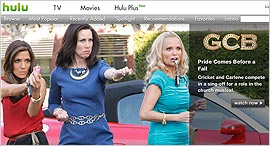 Raising the bar for all online publishers, Hulu has committed to only bill brands and agencies for ads that viewers watch in their entirety.
Raising the bar for all online publishers, Hulu has committed to only bill brands and agencies for ads that viewers watch in their entirety.
“This
is an industry first,” according to Jean-Paul Colaco, Hulu's senior vice president, advertising -- explaining that the move is part of Hulu’s “all in” attitude. “Hulu
advertisers will not be charged unless their advertisement has been streamed through completion.”
The 100% completion rate commitment includes all ads sold by Hulu itself, and will apply
to both Hulu and Hulu Plus, Colaco said Tuesday.
In beta for several months, Zenith Media, General Mills, and Horizon Media all helped Hulu test its new model. The model has the ability
to “minimize waste and maximize effectiveness of video advertising," Rick Hosfield, vice president of content planning and distribution at General Mills, stated.
advertisement
advertisement
More than a mere
marketing gimmick, Colaco sees the move as an extension of Hulu’s intrinsic brand-friendly nature.
Bold as the offer may seem, however, it's important to note the difference between
Hulu's play and YouTube's -- which is employing a pay-per-complete model, according to Michael Greene, an analyst at Forrester Research.
“What Hulu is doing is reinforcing its
status as a premium video publisher by calling attention to its strong user engagement and ad completion rates -- metrics that differentiate it from other publishers, especially those in the mid- to
long tail,” Green explains.
“YouTube, on the other hand, is trying to use consumer ad skipping to its competitive advantage. In a world where users can expect to skip video ads and
advertisers pay for completes, only a publisher with the scale of YouTube can effectively compete on those terms," he adds.
As Forrester senior analyst Joanna O'Connell notes: “YouTube
is also focused heavily on using data to better match advertisers' ads to consumers, based on the likelihood that the consumer will complete the ad. Using data to enhance targeting is
smart.”
Conversely, in 2007, Hulu launched its ad selector, which encouraged viewers to choose among multiple ads to select the one most relevant to them. More recently, Hulu
introduced its ad swap product, which lets viewers replace existing ads for those they feel are more relevant.
Since the launch of ad swap, Hulu has seen over 9 million substitutions,
according to Colaco. The original Hulu service continues to ramp up users and content, while Hulu Plus -- the company’s U.S. subscription service -- passed more than 2 million paid
subscribers in the first quarter of the year.
“Based on our research, Hulu Plus has achieved 2 million paying subscribers faster than any video subscription service -- online or offline
-- in U.S. history,” per Colaco. There will be no extra cost to Hulu advertisers for this new guarantee.